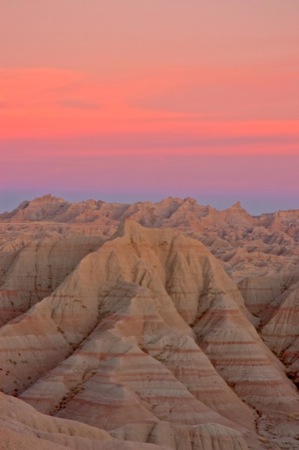
3) Indian art
It’s hard to overstate the role that American Indian heritage plays in the history, culture and art of South Dakota. Lakota, Dakota and Nakota Sioux occupied this corner of the continent long before Lewis and Clark arrived, and many parts of the area, including the Black Hills, were considered sacred ground.
Today, great Indian art helps preserve the traditions of the Sioux and other groups. At Prairie Edge Trading Company and Galleries in Rapid City, visitors will find themselves immersed in the beauty and tradition of Native American art. The establishment began as a trading post, and still supplies hides, beads and other typical items used in Indian art. Today, the store also features galleries full of handmade items, such as spirit shirts, drums and beaded buffalo skulls, as well as Native American paintings and other fine art.
In nearby Deadwood, another kind of art gives visitors a different look at the area’s Indian heritage.
Tatanka: Story of the Bison is an attraction centered around a massive outdoor bronze sculpture that depicts a small herd of 14 buffalos being pursued by three Lakota riders on horseback. The project was conceived by actor Kevin Costner, and a visitors center at the site has information and memorabilia from his work on the film “Dances With Wolves.” Groups that visit Tatanka can talk to Native American interpreters about art, bison hunting and other elements of traditional Lakota life.
4) Western heritage
Spend a few days in South Dakota, and you’ll realize that the whole state still emanates a frontier vibe. Some parts of South Dakota weren’t settled until the early 20th century, and Western heritage and culture permeate nearly every town along the way.
Just outside Badlands National Park, the Prairie Homestead Historical Site gives visitors a fascinating look at the life of a family that staked a claim there in 1909. The highlight of the site is the original sod dugout house that the mother, father and adult son lived in for four years, as well as the wooden claim shack that was later added on. Groups can walk into the humble two-room home and see the furniture, tools and clothing used in the period. Along the way, they’ll gain an understanding of the sacrifices those pioneers made in order to have a piece of land to call their own.
In Pierre, South Dakota’s capital, the Casey Tibbs Rodeo Center honors famous bull riders, calf ropers and other Western athletes who helped make rodeo the state’s official sport. The Hall of Champions features short video documentaries of 19 champion rodeo artists from South Dakota.
Large statues pay tribute to Casey Tibbs, a South Dakota bronco rider, and Mattie Newcomb, who made a name for herself as the world’s fastest trick rider. Other displays explain the intricacies of rodeo events and feature saddles, ropes, costumes and other artifacts from rodeos past and present.
5) Natural splendor
Although it’s South Dakota’s largest city, Sioux Falls still makes plenty of room for nature. For evidence, just look to Falls Park, where the namesake waterfalls cascade through the center of town over lovely pink quartzite rock. There and at other spots throughout the city, groups can enjoy the outdoor splendors of prairie life.
One of the best places to experience nature in Sioux Falls is the Outdoor Campus, which preserves 100 acres of green space in the middle of the city. The campus features an outdoor museum, numerous gardens, a lake and two miles of walking trails. Visiting groups can take workshops in various outdoor activities, from canoeing and kayaking to fishing, archery and outdoor cooking. The campus also features a museum and a 3,000-gallon aquarium.
Adjacent to the Outdoor Campus, the Sertoma Butterfly House introduces visitors to nature from exotic parts of the world. Enclosed in a climate-controlled area, some 800 butterflies from 50 to 60 species swirl among tropical plants; visitors can walk right through the habitat for up-close views and fantastic photos. The Butterfly House also features a small aquarium exhibit with a variety of exotic fish and marine animals.










